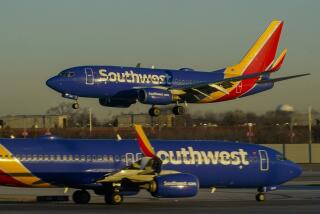Flier’s favorite L.A.-Portland, Ore., flights were discontinued. Why?
- Share via
Question: I often travel between Los Angeles and Portland, Ore. Nonstop works best for me because I have allergy and ear problems, especially on landing and takeoff. I used to fly nonstop on United, but those flights are no longer available. When I asked the United personnel in Portland why, they said, “The route doesn’t pay.” On what basis do airlines make these decisions? Why do they make them as stealth decisions and not inform frequent fliers on a route in advance?
Constance Rumer
Lomita
Answer: Easy answers: money, and because they don’t want to. As with anything to do with airlines, it’s far more complex.
“An airline makes route calculations based on economics,” said Vinay Bhaskara, a senior business analyst at Airways News, an aviation industry publication and analysis firm. “The specific root cause could be anything from lower-than-expected revenue to rising costs for the airline or for the aircraft in question.”
The competition these days among carriers on this route — especially among American, Delta, United, Alaska and Southwest — is stiff, experts say. With profitability never guaranteed, airlines will do what needs to be done to ensure they stay in the black, a place where not many have dwelt consistently.
But it’s not only the rough-and-tumble of route profitability; other factors that squeeze airlines could include the cost of personnel, landing and other airport-related fees, and the type of aircraft (is it older or smaller or both and perhaps less fuel-efficient?) and, in turn, the cost of fuel, Bhaskara said.
If a route is discontinued, the resources can be deployed elsewhere.
What’s the harm in telling your frequent fliers? Bhaskara noted that public companies are all about generating value for shareholders and avoiding anything that might shake investor confidence.
Warren Chang, the vice president and general manager for Fly.com, an airfare search engine, cited another business reason: “They may not want to give the competition any insight into how good or bad their business was on a specific route.”
Transparency, it appears, goes only so far. “New additions they trumpet,” George Hoffer, professor of economics at the University of Richmond in Virginia, said in an email. “Failures or cutbacks, they are silent. I think that is true in any industry.
“In the airline industry, if a route is to be eliminated or downgraded (in frequency or connections), why give the customer an early incentive to defect and have a lower load factor as the schedule change date nears? I think basically no firm wants to admit failure, which downgrading service is, even if it means reallocating your resources to a higher use — a route with a higher return.”
Thus the traveler may not find out until he tries to book that route. Or if the airline makes the change at the last minute — and they often do that, Bhaskara said — the traveler may be aware only when receiving some communication from the carrier — or if things go amiss, not at all. (Chang notes that “it is the booking agent’s responsibility to contact the user. If you booked with United, it is United’s [responsibility] to inform the traveler. If you booked with Expedia, it’s Expedia’s responsibility.”)
If you’re on the road, you may not get word in time to adjust your schedule. Chang suggests you always reconfirm flights. That may sound like overkill, but remember that airlines are an ongoing surprise party, and a flight change, sadly, doesn’t come with presents, a cake and, especially, a large group of people who love you.
Have a travel dilemma? Write to travel@latimes.com. We regret we cannot answer every inquiry.
More to Read
Sign up for The Wild
We’ll help you find the best places to hike, bike and run, as well as the perfect silent spots for meditation and yoga.
You may occasionally receive promotional content from the Los Angeles Times.







